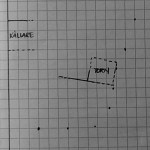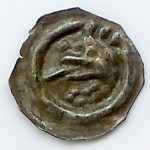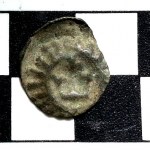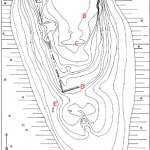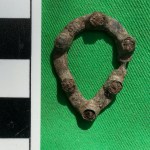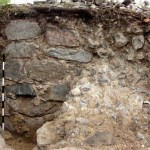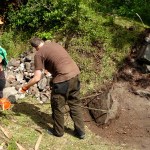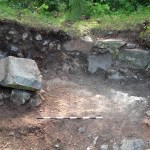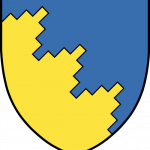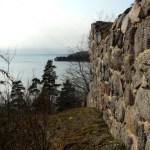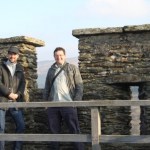Castles
Last year I headed four weeks of excavations at two previously unexplored castle ruin sites near the Swedish city of Norrköping: Landsjö in Kimstad and Stensö in Östra Husby. Finds and written sources suggest that both were built and inhabited in the 13th and 14th centuries. All known owners were members or close relatives of the powerful Ama family. Now Ethan Aines and I have finished the archive reports, available here on ScienceBlogs [Landsjö and Stensö] and on Archive.org. Rudolf Gustavsson's osteological reports (in Swedish) are included. Comments and questions are most welcome…
Things are coming together with the post-excavation work for last summer's castle investigations so I'm putting some stuff on-line here.
I've submitted a paper detailing the main results to a proceedings volume for the Castella Maris Baltici symposium in Lodz back in May. There are no illustrations in the file, but you'll find all you need here on the blog in various entries tagged ”Castles”.
Osteologist Rudolf Gustavsson has completed his reports on the bones from the two sites (Landsjö – Stensö).
For the Dear Reader who doesn't read Swedish, a short summary of Rudolf's results is in order…
Landsjö castle. State of knowledge after the 2014 excavations.
I'm giving a talk on Landsjö castle to the Kimstad Historical Society next week, and while preparing my presentation I made a sketch plan of this summer's discoveries regarding the plan. The ruin just barely breaks the turf, so we didn't know much about the castle's layout beforehand except that it had a 60-metre straight stretch of perimeter wall along the west side and that it cannot have been rectangular.
Our main architectural discoveries in two July weeks of digging and clearing brush were as follows.
1. A wall divides the…
Deep in a single square metre of trench D at Landsjö castle, on the inner edge of the dry moat, we found five identical coins. Boy are they ugly. They're thin, brittle, made of a heavily debased silver alloy and struck only from one side; they bear no legend and the image at the centre is incomprehensible. But I love them anyway, because they offer a tight date: this coin type was struck for King Valdemar Birgersson c. 1250-75. And the first written mention of Landsjö dates from 1280, so it all works out.
Valdemar became king because he had an extremely powerful and ruthless father, the jarl…
A fun thing about historical archaeology, the archaeological study of areas and periods with abundant indigenous written documentation, is when the archaeology challenges the written record.
According to the patchily preserved historical sources, Landsjö hamlet was a seat of the high nobility in about 1280 but then became tenant farms no later than 1340. This means that the castle on Landsjö islet was probably in good defensible shape and inhabited in 1280 but not after 1340.
During last week's excavations we found a previously unknown strong wall delimiting the castle's high inner bailey,…
Christian Loven's plan of Landsjö Islet with letters marking on-going fieldwork.
Landsjö castle is on a high islet in the lake next to the modern manor house. Nobody ever goes there. The ruins are covered by vegetation and they're in bad shape: only along the western side of the islet do they rise even a metre above the rubble and accumulated forest mulch. Visible is a 59-metre N-S stretch of perimeter wall with a preserved corner at either end, and a shorter W-E stretch of perimeter wall from the south-western corner. Along the inside of the visible wall are vague suggestions of two…
With two days of digging and one day of backfilling left at Stensö Castle, trenches A and B have already given a rich harvest of new information.
The northern tower was a green ruin mound when we came to site. We now know that the tower was built entirely of greystone, it was round with a diameter of about 5.5 m, and it was planned and built together with the perimeter wall. The lost western half of the latter did not join the tower on a radial line. Instead more than half of the tower's circumference was outside of the perimeter wall, allowing flanking, where bowmen in the tower could strafe…
Compare the disc from Stensö to these "fairy stone" calcium carbonate concretions from the Harricana River in the Abitibi-Témiscamingue admin region, Quebec, Canada. The Stensö piece has been sanded smooth and flat on one side. Locally these things are known as marlekor or mallrikor.
Thanks to project advisor Lotta Feldt of the Östergötland County Museum for setting me on the right track.
After four days of rubble removal in trench A, we found the south wall of Stensö Castle's northern tower. Note how the wall facing (left) ends, and a pale mass of wall core (lower right) emerges out of the tower. This is the castle's previously unseen western perimeter wall.
Our first week of two at Stensö is over, and already Chris, Fanny and Simon have made trench A answer the question we've asked of it. Way back in line with the trench's top edge on the flank of the northern tower's ruin mound, they've uncovered a neat wall face of dressed ashlar, and out of this tower wall projects an…
Medieval walls are usually shell walls, where you construct an inner and outer shell of finely fitted masonry while filling the space between them with a jumble of smaller stones and mortar. Usually the facing stones don't project much into the core. When the wall is allowed to erode, once the cap stones have fallen off, the facing starts to peel from the core one ashlar or brick at a time from the top down. Before the resulting rubble layer's top (rising) reaches the level of the wall's eroding top (descending), halting erosion, you'll see a ruinous wall that is thick and smooth-faced in its…
Stensö castle, trench C, the part along the perimeter wall. Note the ashlar.
Drove down to Vikbolandet on Sunday night with my excellent colleague Ethan Aines from Stanford, and we were met at expedition HQ by seven of my Umeå students from last autumn semester. Very pleased to see them again! They've just finished their second term and several are scheduled to go on to the third. So I'll be seeing them in the halls in September when I take on my second batch of Umeå freshmen, and if I'm lucky I'll get to supervise a few of them for their BA theses. Everyone's being charming and nobody…
It's Sunday morning and I'm getting ready for four weeks of excavations. I haven't done any digging since the Pukberget cave dig in 2011, and my last multi-week dig with a big team was at Sättuna in 2008. So it's high time, and I'm excited. Getting stuff from my study, packing stuff at home, buying some extra tools and a lot of food.
My crew of ten will be assembling at a farm-labourers' dorm in Östra Husby starting tonight, and tomorrow we break turf at Stensö castle ruin as the first archaeologists to dig there. Most team members are first-year students from Umeå whom I taught during the…
My excavations this summer will target the ruins of two Medieval castles near Norrköping. Christian Lovén and I have selected these two because unusually, both have curtain walls (Sw. ringmur) but do not seem to have belonged to the Crown. The High Middle Ages in Sweden are poorly documented in surviving written sources, but in one of these cases we actually have a pretty good idea who built the castle and when.
Landsjö in Kimstad parish enters the record in about 1280 when an old woman writes her will. She's Kristina, daughter of a certain Faste who had borne a plant device on his coat of…
I drove down to Norrköping Thursday morning to look at two small Medieval castle ruins for my new project. The one at Landsjö in Kimstad is difficult to reach because it's on a small island in a lake where nobody keeps a boat. So I had bought one of those big tractor-tyre things (that people tug after their motorboats) and a hand pump, and borrowed a kayak paddle from my dad. Turned out that the textile sheath that forms the floor of the ring I was sitting in was anything but watertight, so my bottom got soaked in 5°C lake water. No matter, I was thrilled to get out to the island, which is…
Here's a guest entry from my friend Professor Howard Williams of the University of Chester. He was my charming guide on an antiquarian road trip Sunday.
I met Martin at his luxurious guest accommodation on the main campus of the University of Chester and we got into my trusty VW. We left Chester, heading around the historic city and out on the Wrexham Road over the 18th-century Grosvenor Bridge over the River Dee and into Wales. Driving along the A55 along the spine of Flintshire, we stopped near Whitford to investigate two sites.
First, we visited the 3.4m-high early medieval cross-slab at…
